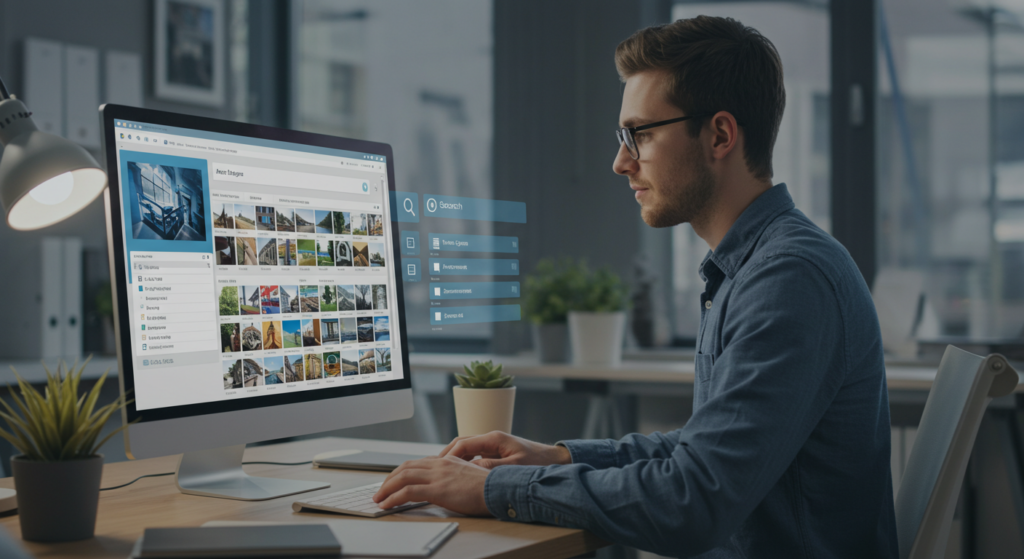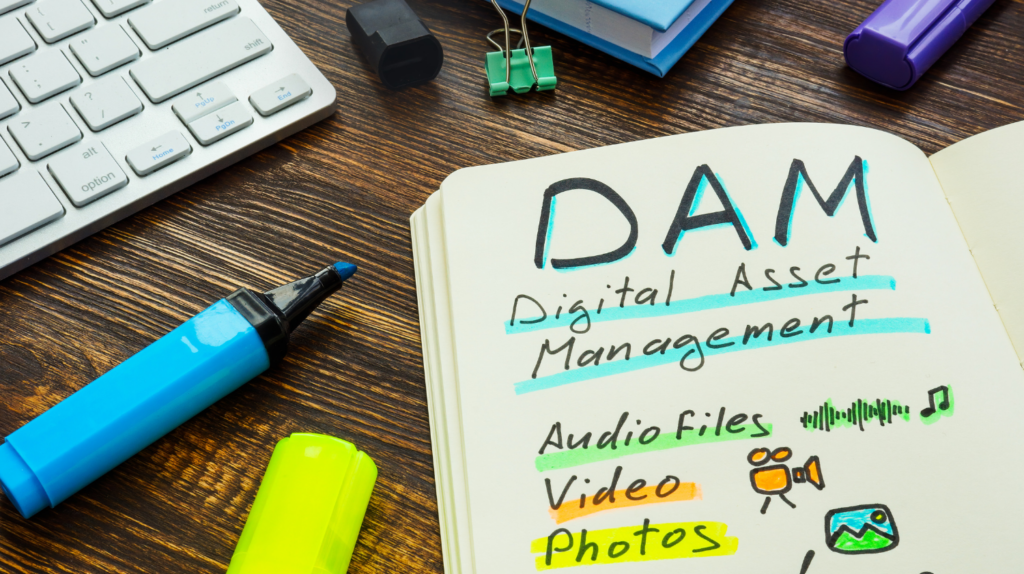The digital asset management market is projected to quadruple to over $12 billion by 2030, driven largely by AI integration and the explosive growth of digital content. Yet most organizations are still managing their assets like it’s 2015, scattered across drives, buried in folders, and impossible to find when deadlines loom.
Whether you’re evaluating your first DAM system or recognizing that your current platform can’t keep pace with AI-powered content demands, having the right digital asset management checklist can help you make the improvements needed. Teams are creating more content to meet demands, working remotely across time zones, and facing stricter compliance requirements while trying to deliver personalized experiences at scale.
The digital asset management platforms that will dominate the next decade are intelligent content operations systems powered by artificial intelligence, predictive analytics, and automated workflows. The difference between a basic DAM and a future-ready platform could determine whether your team thrives or drowns in the coming content tsunami.
This comprehensive checklist covers 33 essential elements every modern DAM system should include, from foundational features that any platform must have to cutting-edge AI capabilities that separate industry leaders from legacy providers.
12 Basic System Offerings to Inspect in Your Digital Asset Management Checklist
Every great digital asset management platform starts with a solid foundation of features that make your life easier. Before buying new software, make sure you understand these basic elements and mark them off your digital asset management checklist.
1. Uploading Process
What is the process for uploading new assets to the system? What options are there for adding metadata? Also, ask about what’s involved in the process of migrating a large volume of assets at once and how long it usually takes. This will help you prepare for implementation.
2. Organization
What does the software offer to help you stay organized? Familiarize yourself with the interface and all available options for grouping your assets. Learn about tagging, creating a folder hierarchy, and more within the software.
3. Search Tools
What are the search capabilities like? Learn about the platform’s features for enhanced findability. Some DAM systems may even use artificial intelligence to make search smarter, enabling users to find relevant assets on vaguer searches.
4. Supported File Types & Conversion Options
Which file types and sizes are most compatible with the system? Also, ask whether assets can be converted into other file types either within the platform or upon download.
5. On-Brand Asset Creation
What features of the software can help your team properly and consistently create branded assets? For example, will your brand guidelines be easy to keep up to date in the system? Can the system learn your branding to generate new branded content? Find out from your chosen provider prior to purchasing.
6. Asset Archiving
What is the process for archiving assets as they become outdated? Explore cold storage features that allow you to expire assets on a specific timeline and keep users informed about assets they should no longer use.
7. Version Control
How does the system deal with multiple versions of the same asset? Will it automatically show the most recent version of every digital asset? Learn about how it handles storing old versions of an asset without confusing users.
8. Security & Access Control
How does the platform keep your assets and data safe? Discuss features like asset encryption, access controls, and penetration testing after major system updates.
9. Privacy & Compliance
How can your DAM solution help you follow relevant privacy guidelines? See if the software’s team has experience dealing with legal protections like GDPR (General Data Protection Regulation in the EU) or PHI (protected health information).
10. Asset Sharing
How can you share assets with outside sources? Discover the options for creating public links, setting temporary passwords, brand portals, and more.
11. Integrations
How will the new software fit with your current marketing technology (martech) stack? Find out which tools have pre-built integrations with the DAM platform and which ones may require more custom work to interlace.
12. Cost Structure of Storage Space & Users
How much will the system cost, and when will the price rise? Most companies don’t advertise this information publicly, so get in touch with representatives of the platforms you’re most interested in to find out about their specific cost structures.

9 Added Features for Optimized DAM Processes
Once you have a handle on the basics, consider your organization’s needs and priorities within these nine advanced elements of digital asset management systems.
1. Customizability
Different digital asset management platforms provide more basic, ready-to-use automations or options for highly complex custom workflows. To make the system efficient for your organization, discuss ahead of time what your team needs. Then, ask the platform’s representatives for practical advice on how to make the workflows you’re envisioning happen within their system.
2. Enterprise-Level Features
Larger and more complex organizations require enterprise-grade cybersecurity, asset storage and findability, and customer support. Ask your potential provider for more information about how they serve enterprise-level businesses.
3. Customer Service
Dedicated customer service will go a long way in making the implementation process easier. You’ll want to be able to easily reach someone who is familiar with your system setup to get help when you encounter technical problems. Check for well-built self-serve options like a large online support community, training center, and knowledge base.
4. Intelligent Asset Management Capabilities
Ask about how the software leverages artificial intelligence to make your use of the system more efficient. Options for AI enhancement include:
- Clickable smart tags available on asset upload based on the system’s knowledge of your current assets and taxonomy
- Optical character recognition (OCR) that finds text in images and videos and adds it to their metadata
- Content coaching to help you edit and improve new content and repurpose existing pieces
- Generative AI to add new backgrounds to old images, write content outlines and social media posts, and more
5. Collaboration Features
Learn how the new system can make your content operations more efficient and team collaborations seamless. Explore functions like:
- Commenting directly on assets with revision requests
- Sending notifications to the next person who needs to work on an asset
- Setting up workflows to automatically send completed asset drafts to reviewers like managers, legal teams, and compliance officers
- Marking assets as approved by different departments as they complete reviews directly in the system and automatically notifying the asset owner
- Helping managers keep an eye on content creation efforts and timelines with project management notifications
6. Digital Rights Management (DRM)
If your company frequently deals with licensing stock imagery or content from other authors, see if the platform has any features that help you with digital rights management (DRM). Some DAM software stores licensing information in the asset’s metadata and notifies you as licenses expire.
7. Distribution and Publishing Options
More robust DAM systems offer advanced features for intelligent content distribution once an asset is approved. Modern platforms go beyond basic publishing to deliver personalized content at scale across multiple channels. Look for systems that provide:
- Real-time asset optimization that automatically transforms content based on audience demographics, device types, or channel requirements, delivering the right format, size, and messaging variation without manual intervention. Dynamic content adaptation ensures your brand messaging resonates whether it’s appearing on social media, email campaigns, or your website.
- Audience-specific publishing workflows that route different asset variations to appropriate channels based on predefined rules or AI-driven recommendations. This allows you to handle every aspect of a digital asset’s lifecycle in one place while ensuring each audience segment receives the most relevant content experience.
- Automated personalization rules that trigger when certain conditions are met, such as geographic location, user behavior patterns, or campaign objectives, enabling your team to scale personalized experiences without exponentially increasing workload.
8. Analytics & Reporting
Advanced reporting capabilities should provide personalization intelligence that drives strategic decisions. When evaluating platforms for your digital asset management checklist, prioritize systems offering:
- Personalization performance tracking that measures how different asset variations perform across audience segments, channels, and campaigns. This includes conversion rate analysis, engagement metrics, and attribution data that shows which personalized approaches deliver the strongest ROI.
- Content effectiveness insights that identify patterns in asset performance, revealing which creative elements, messaging approaches, or visual styles resonate most with specific audience segments. These insights feed directly back into your content creation and personalization strategies.
- Predictive analytics that leverage historical performance data to recommend optimal content selections for future campaigns, suggest new personalization opportunities, and forecast which assets will likely perform best with specific audiences.
- Cross-channel attribution reporting that tracks how personalized content performs throughout the customer journey, showing how different touchpoints contribute to conversions and helping optimize your overall content strategy.
9. Scalability
You’ll want a system that grows with you as your team creates more content and assets more quickly. Find out the system’s limitations, what it will cost to upgrade to new storage and user tiers, and how well the software handles larger volumes of assets.

12 Steps to Build a Strong DAM Strategy
Now that you know all the features that play a role in efficient digital asset management software, follow these 12 steps to build a robust strategy. Start with finding the right system, then build and implement a plan for long-term DAM success.
1. Set Goals
First, check in with the personnel who handle assets the most. This often includes groups like:
- Marketing: Managers and strategists planning, executing, and measuring the performance of campaigns that use written content, branded graphics, and videos
- Creatives: Writers and designers making and collaborating on new written and visual content
- Sales: Top sellers using collateral, presentations, and contract templates to seal the deal
Use feedback from these groups about their biggest challenges with creating, finding, and using digital assets to decide on your priorities and goals within a new system.
2. Audit
Dig through your current digital storage systems to determine the type and volume of assets you’ll want your new solution to handle. In a comprehensive digital asset audit, set your organization up for success by:
- Deleting noticeable duplicates and unusable, outdated assets for a better idea of how many assets you actually have
- Getting a general idea of which assets you’ll want to move over and which you no longer need
- Creating a timeline and rough plan for asset cleanup before migrating to a new system
- Prioritizing the most often used assets for more immediate migration and saving less urgent items for later
3. Research
Once you have clear goals for getting a new platform and know more about the assets that you plan to migrate, research available DAM options. Note which platforms meet your must-haves and create pros and cons lists for the best ones you find.
4. Choose
When you’ve narrowed down your list to only the top contenders, attend demos and ask for proposals from the top few. After reviewing, present your findings to key decision-makers and ultimately pick the option that best suits your organization’s specific priorities and goals.
5. Prepare Assets
At this point, you’ll want to do a deeper cleaning of your current digital asset library to prepare for migration. This step includes:
- Thoroughly sweeping to capture and delete all old and irrelevant digital files
- Choosing which of the remaining duplicates is the correct version, then completing deletion or merging
- Updating files that are poorly named with more logical naming conventions
6. Build Taxonomy
Your organization’s digital asset taxonomy is the vocabulary used to describe and categorize assets. At this point, decide how your DAM software should ingest and organize new assets, including:
- Which metadata (or background information) users should add upon uploading new asset files
- Pre-set tags like specific product or brand names to place on different assets
- Naming conventions for new assets to make them as discoverable as possible
- Folder hierarchy within the system and how assets should be categorized based on their use cases
7. Migrate
Now, it’s time to move existing content over to your new system. Plan to do this in phases based on which assets are most used and which you can wait on.
This will give you more time to do a thorough cleanup on all the files in your current storage system. It will also allow you the ability to test your plan and make tweaks to folder hierarchy and taxonomy to optimize the discoverability of new uploads.
8. Integrate
Put all the pieces of your martech stack together by setting up integrations with your:
- Content management system (CMS) on the backend of your website
- Project management software
- Customer relationship management (CRM) system
- Internal communication tools like team messaging systems
- Design and content creation tools
- Distribution tools like social media managers and marketing email platforms
9. Add Users
Create custom roles and establish which asset groups each role will be privy to. Then, add users, assigning them to certain roles as you go.
10. Train
Teach personnel how to use the new system. Use a variety of methods in different stages to encourage user adoption, including:
- An in-depth onboarding session with a walkthrough of the interface, what it should be used for, and what your processes should look like in it
- A delegated point person to answer questions about the system as employees start using it
- Regular check-ins on how employees are using the software and what issues they may be encountering
- Ongoing encouragement for employees to provide feedback and new ideas for how best to use the system
11. Organize
As your asset library continues to grow, use these best practices to avoid clutter:
- Set assets to expire, which will mark them as unusable when they’re no longer relevant
- Periodically review your user roles to control who can upload, edit, change, or remove different types of assets
- When your system detects duplicates, review which one is the best to keep
12. Review & Optimize
Set up regular reviews of your system and how it’s working, such as once a quarter. At these meetings, discuss any problems users are running into and brainstorm solutions. Also, research any new features that may be available to you and come up with new ideas to make your team’s use of the software more efficient.

Digital Asset Management Checklist FAQ
How do I know if my organization needs a DAM system?
If your team spends more than 30 minutes per day searching for digital assets, struggles with version control, or can’t easily share branded content with external partners, you likely need a DAM solution. Research from McKinsey shows that employees spend 1.8 hours every day searching and gathering information, making DAM implementation a productivity imperative rather than a luxury.
What’s the difference between basic file storage and a true DAM platform?
Basic file storage solutions like Google Drive or Dropbox simply store files in folders. A comprehensive DAM platform provides intelligent search capabilities, automated metadata tagging, workflow management, brand compliance tools, and advanced analytics. When building your digital asset management checklist, prioritize platforms that offer AI-powered features like predictive metadata and smart content recommendations rather than glorified file cabinets.
How long does DAM implementation typically take?
Implementation timelines vary based on asset volume and complexity, but most organizations can expect 6–12 weeks for full deployment. This includes asset migration, taxonomy setup, user training, and integration with existing marketing technology stacks. Professional services teams can often accelerate this process, especially for large-scale implementations involving millions of assets.
Should AI features be a priority when evaluating DAM platforms?
Absolutely. AI capabilities like automated tagging, intelligent search, and content personalization are essential for staying competitive. Organizations using AI-powered DAM systems report up to 72% faster asset discovery times and significantly improved content reuse rates compared to traditional platforms.
How do I measure ROI from a DAM investment?
Track metrics like time saved on asset searches, reduction in duplicate content creation, improved campaign launch speeds, and increased asset reuse rates. Many organizations see ROI within the first year through productivity gains alone, not counting the additional benefits of improved brand consistency and compliance management.
Walk Through Your Digital Asset Management Needs With Our Team
See how Aprimo’s robust, highly customizable, and easy-to-use DAM solution fills in your organization’s digital asset management checklist. Request a free demo to learn the basics of the platform, ask about advanced features, and discover how Aprimo can help you build a long-term plan for strong digital asset management.


